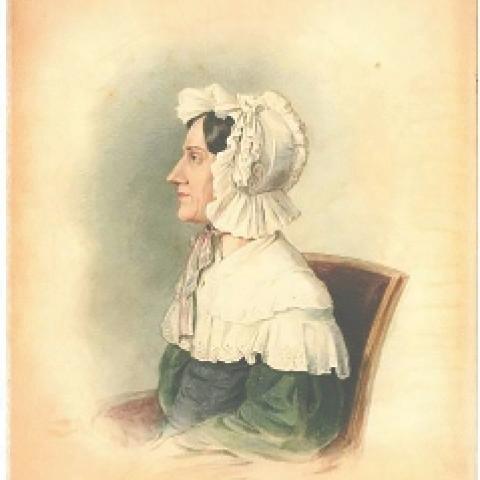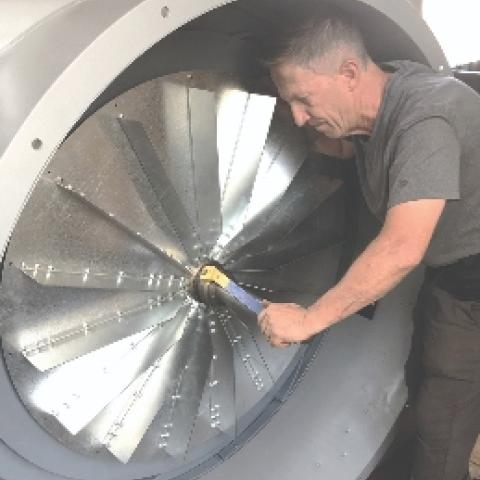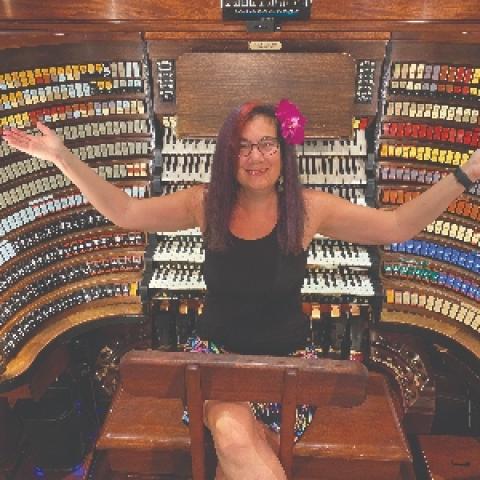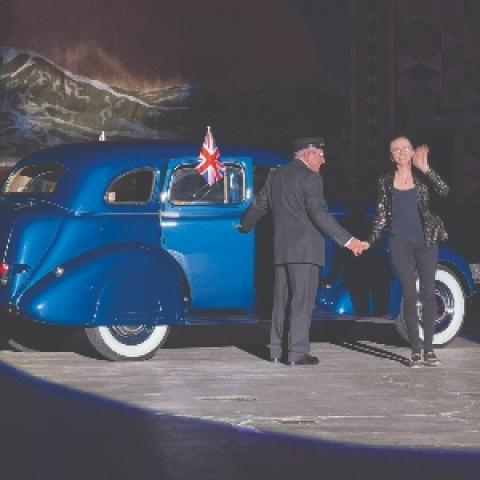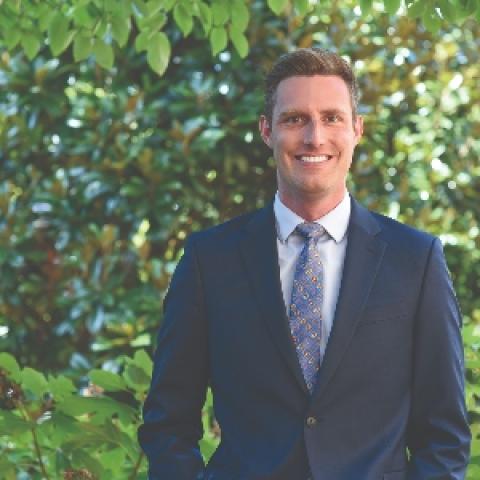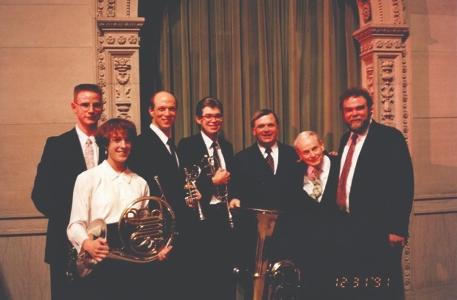
Covering all the basses
I remember the first time I went to Fenway Park in Boston with my father to see a Red Sox game. I had watched many games on television, but those of us “of a certain age” remember what televisions were like in 1965 with foil-wrapped rabbit-ear antennas, bulbous black-and-white picture tubes, and fuzzy pictures. When Dad and I came out of the tunnel into the sunshine at Fenway, the outfield grass was the greenest I had ever seen. I was dazzled.
The first time I heard a symphony orchestra live, those double basses took my breath away. I thought their rich sonorities, enhanced by the storied acoustics of Symphony Hall in Boston, were otherworldly, something that cannot be duplicated by a recording. I remember that magical first time whenever I hear those tones.
Robert Augustus Melcher (1910–1983) was a professor of music theory at the Oberlin College Conservatory of Music from 1937 until 1976. He perennially taught the required two-semester freshman theory course Music Theory 101 and 102 along with a following sophomore course 201 and 202. I was a sophomore at Oberlin in the academic year of 1975–1976, his last year of teaching. Dr. Melcher’s teaching methods included fear and intimidation. He never hesitated to humiliate a student who answered incorrectly in class, and woe betide the one who was caught gazing vacantly across Tappan Square. He was particularly hard on singers, and he fawned over organ majors, calling us “theory prone” because of our understanding of basslines, which he called the driving force of music.
Dr. Melcher was right about basslines. As a Sunday morning organist and today as a sometimes congregant, I love how the basslines of hymns provide foundation, define harmonies, and inspire motion. As a frequent concert goer, I love how cellos, double basses, trombones, and tubas define the motion of Classical and Romantic symphonic music. As an organbuilder, I love the majesty of the wonderful bass sonorities driven by all that wind. It is fundamental.
§
I was curator of organs at The First Church of Christ, Scientist (The Mother Church) in Boston in the 1980s and 1990s, where the principal instrument is Aeolian-Skinner Opus 1203 completed in 1952. It is a heroic organ with eight divisions, 240 ranks, and well over 13,000 pipes. It is something like eighty feet wide, forty feet tall, and twelve feet deep, beautifully organized and engineered because, unlike most organs of this size, it was built all at once under a single opus number. There is a full-length 32′ Kontrafagott enclosed in the Swell along with the rarity of a 5-1⁄3′ Quinte Trompette, four Pedal 32′ stops, and a Pedal division with over forty-five independent ranks.
The music in Christian Science worship services is described in the church’s manual, Science and Health With Key to the Scriptures, by Mary Baker Eddy, founder of the church. There are three hymns, organ prelude and postlude of prescribed length, and devotional music provided by a solo singer accompanied by the organist. When the church leadership planned to join Boston’s fabulously popular New Year’s celebration, First Night, by offering a concert with organ and brass, the church’s organist, Thomas Richner, known to many of us as “Uncle T.,” asked if I would be the organist because he was not comfortable playing with ensembles.
What a thrill, what a great opportunity, the height of my performing career. There were 3,000 people in the audience and a brass quintet from the Boston Symphony Orchestra. With that huge organ under my hands, I’d be King of the Hill. We would play all the usual barnburners for brass and organ—Purcell, Clarke, Handel, Gigout; but there came Chester Schmitz, tuba player for the BSO, and I had a tiger by the tail. The power and energy of his bassline up close and personal was something I had never experienced. It reminded me of standing on the platform of a railroad station when an express train blasts through—the sense of force and power followed by a swirling cloud of dust and paper. I was once on a ferry from Rafina, Greece (an hour drive east of Athens), to the Island of Andros in a heavy gale. Standing on the open upper deck hanging on to the rail with my erstwhile hair and present clothing pushed straight back, I remembered Chester Schmitz’s bassline, as wide and powerful as the wind over the sea. The trumpets were terrific, horn and trombone all you would expect from principal players in a powerful, modern symphony orchestra; but Chester’s bassline ruled the day.
Who’s going to play the melody?
On March 23 of this year, Scott Simon, host of Weekend Edition on National Public Radio, interviewed jazz bassist Christian McBride, who had just released a duet recording with his friend and colleague, bassist Edgar Myers. McBride shared that he and Myers had a mutual admiration society for many decades, and that coincidentally they were both at the festival known as Jazz Aspen some twenty years ago. When it was announced locally that they would play an unscheduled duet concert at the festival, a friend wondered, “But who’s gonna play the melody?” They played concerts and tours together over the years, and this is their first recording together. The title? But Who’s Gonna Play the Melody?
In the various cuts of the recording, they swap back and forth between bassline and melody, even accompanying each other on the piano. It was a creative look into the solo possibilities of an instrument typically associated with bass, made especially interesting by the equality of the two players and their shared inventive exploration. During the ten years Wendy and I lived in Greenwich Village, small jazz combos were a regular part of our entertainment life as we visited with friends in restaurants and bars, and I enjoyed listening to the ubiquitous bass player taking a turn as a soloist, wandering down the instrument’s fingerboard to find the highest treble range, plunking about up high while maintaining the rhythm, then returning “home” to the role of providing bass while accepting the patter of applause from listening patrons. McBride and Myers took that scene many steps further, obviously enjoying the unusual pairing of their instruments and outlooks.
Continuing the bass
The underpinning of most Baroque music is the basso continuo, the duo comprising a bass instrument, usually viola da gamba or cello and sometimes a bassoon, and a keyboard, usually harpsichord but sometimes an organ doubling the bassline and adding harmony above. Since the bassline needs two players, it takes three to play a solo sonata and four to play a trio. The harmonies for the keyboard are indicated by a system of squiggles, actually numbers, under the printed bassline, numbers that form chords by indicating the notes above the bass note. For example, if the bass note is C with a 3 and 5, you play a C-major chord. If it is C with a 4 and a 6, you play an F-major chord in second inversion. It is a magical system left over from the ancient tablatures that predated our modern music notation. It also reminds us of a chart for a jazz arrangement that gives a bassline and indicates chords. It is a license to improvise, and it is an admirable art.
One of my favorite moments in the literature of basso continuo is the end of the alto aria, “Esurientes implevit bonis, et divites dimisit inanes” (He has filled the hungry with good things, and the rich he has sent away empty) from Magnificat by Johann Sebastian Bach. The singer is accompanied by two flutes and basso continuo, the flutes with a lovely E-major melody in parallel sixths and imitative passages. The alto finishes in measure thirty-six, and the flutes reprise the opening, which becomes the conclusion, but Bach’s gentle genius has them leave us abruptly in mid-resolution while the continuo plays the last chord alone, sending “the rich away empty,” a poignant rebuff.
The catalog of Bach’s cantatas is a dazzling list of masterpieces, some for solo singer with a small ensemble, and some swashbuckling monumental tours-de-force with large orchestra including brass and timpani, chorus, and multiple soloists. Some of music’s most famous passages are included—it is hard to imagine a world without “Jesu bleibet meine Freude” from Cantata 149. It would take some nerve to choose a favorite among the myriad, but I have nerve enough to name mine, Cantata 21, Ich hatte viel Bekümmernis. It is a huge, eleven-movement piece with four choruses and solos and duets for soprano, tenor, and bass. After the mournful opening “Sinfonia,” the first movement is of special interest to organists as it is a fugue with the same subject as BWV 541, Prelude and Fugue in G Major, but in the cantata, the subject is in C minor, a striking comparison.
The continuo keyboard instrument is organ, and the bassoon doubles the continuo part for some movements and has an independent part in others. The ninth movement, “Erfreue dich Seele, erfreue dich Herze” (Rejoice my soul, rejoice my heart), is a snazzy aria for tenor and rollicking continuo, with fast bass scales and skipping-down-the-lane hemiolas that gives the continuo player an opportunity to create melody. What a privilege.
We know a great deal about Bach’s affinity with numbers and math. His music is loaded with mathematical relationships, and works like Cantata 21 are supremely organized. In the context of all that precision, the continuo part is an intimate invitation to improvise, a generous opportunity for creativity. The basso continuo is a colorful underpinning for the melodies, chords, and counterpoints that soar above. Basso continuo is the model for some more recent applications, like the bass and rhythm guitars in a classic rock band, the tuba-and-banjo duet of a sleepy Dixieland ballad, or any musical expression where a bassline with improvised chords accompanies a solo instrument or voice.
Supporting an orchestra
The ubiquitous 16′ Bourdon is found even on one-manual instruments with just a few voices, speaking an octave lower than unison pitch, doubling the bassline of hymns like the double basses of the orchestra. When an organ is large enough to include a 16′ Principal with open pipes, the pedal line takes on a new life, bringing both depth and clarity to the overall sound of the organ, and things really get profound when the bassline is emphasized by a 32′ stop. Because the Organ Clearing House specializes in the hoisting and rigging part of organbuilding, we are often called to handle the monster pipes of 32′ stops in which a single pipe can weigh a ton and produce a pitch at about sixteen cycles per second, which is below the range of human hearing.
Jason McKown (1906–1989) was my predecessor as curator of the organs at The Mother Church. He was an original Skinner man who had cared for the organ since its installation, who told stories about working next to Mr. Skinner on local installations when McKown was in his twenties, including Opus 692, built in 1928 for West Medford Congregational Church in West Medford, Massachusetts. He cared for that organ for fifty-nine years until I took it over in 1987.
The first organ installed in Boston Symphony Hall was built by George Hutchings in 1900, Opus 481, and included the king of organ stops, a 32′ Double Open Wood Diapason. Jason remembered seeing those noble pipes cut into pieces, piled on the sidewalk in front of Symphony Hall ready to be hauled away as scrap lumber in preparation for the installation of a new Aeolian-Skinner organ in 1947. Given that the Aeolian-Skinner organ in Symphony Hall had “only” a 32′ Violone and was never considered the equal of the mighty orchestra, that chopped up 32′ rank seemed a sad waste. When Foley-Baker, Inc., modified and enlarged the organ in 2004, they added a new 32′ Contra Bass and a huge wood Diapason with Haskell basses, a technology that inverts a tube into the pipe increasing its functional length with the side effect of providing more prompt speech.
I had a conversation with Mike Foley of Foley-Baker about the decision to use Haskell basses in which he noted that the conductor of a modern symphony orchestra is used to the instant speech of the double basses (and don’t forget Chester Schmitz’s cannon fire tuba notes) and is not willing to wait around for a lazy organ pipe to find itself and settle on a pitch. Wendy and I were present when the organ was played with the orchestra for the first time. James Levine was the conductor, Simon Preston was the organist, and it will not surprise you that they played Camille Saint-Saens’ Symphony III (the “Organ Symphony”). We had series tickets with seats just over stage right in the first balcony, the perfect seats for piano concertos, and the organ console was placed right under us.
In Symphony III, the organ enters in the adagio section of the first movement with a double-low A-flat followed by bass passages in D-flat major. When those magical deep notes came from the organ, we watched the woodwind players nudge and smile at each other; no other instrument can match those sonorities. Igor Stravinsky despised the organ, calling it the “monster that never breaths.” But how could the instrument produce such wind-driven tones without breathing?
Dad
We have just passed the tenth anniversary of my father’s death. Dad was an Episcopal priest who loved the music and liturgy of the church. He loved baseball, and he loved gardening. Evening primroses from his garden are in our yard in Maine. He had a special church voice that we heard only when he was celebrating the Eucharist. He really celebrated it, not in a here-we-go-again mumble, but in a full bold voice with a touch of singsong, distinctly different from any other of his tones of voice. He supported the music of the church and was involved in the commissioning of two new pipe organs.
I went with Dad to dozens of ball games at Fenway where we shared a streak of twenty-five consecutive opening day games. A large part of my adult relationship with Dad happened in section 26, row 4, seats 13 and 14, seats that he held for over forty years. John Kiley was the creative and revered organist at Fenway, and we made a point of getting to the park early so we could hear “the preludes.” Kiley was also a church organist who slipped lots of hilarious little hints into his improvised reactions to unusual plays, like bursting into the “Hallelujah Chorus” when Carlton Fisk’s long fly ball bounced off the left field foul pole as a fair ball, home run, winning game five of the 1975 World Series.
As rector at the Parish of the Epiphany in Winchester, Massachusetts, Dad stood up for the Civil Rights movement and protested the Vietnam War in a town known as the place where “the politics meet the zip code, Zero-1890.” He educated the parish when the beloved organist Larry Berry was dying of AIDS and parents wanted to pull their children out of the choir, and when parishioner Yo-Yo Ma came to his office offering to play the cello as part of a Christmas Eve service, Dad said, “Larry plans the music here, we’ll have to speak with him.” He was the first in the Diocese of Massachusetts to hire an ordained woman as a full-time member of staff and was chair of the Standing Committee that nominated Barbara Harris as the first woman bishop in the Episcopal Church.
The day Dad died, I was working with my colleague Amory Atkins at St. Paul’s Cathedral in Boston, the church where my parents were married. It was Amory’s birthday. There were twelve priests and four bishops in robes at Dad’s memorial service. I miss him.

